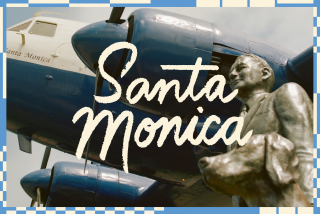Lovely Site to Study the Lowly Sea Urchin
- Share via
Don’t be fooled by the glamorous facade of the Kerckhoff Marine Laboratory, the 1920s-era building complete with castle-like tower that sits in China Cove, near the entrance to Newport Harbor.
Inside, the building looks like the biology lab that it is, complete with cluttered desks, high-tech microscopes and windowless research rooms, where the the million-dollar ocean view goes begging.
The Kerckhoff lab, directly across from the Newport jetty, amid stylish homes and a high-rise apartment building, has been part of Caltech’s biology department since 1929.
If you have ever gone in or out of Newport Harbor by boat, you have probably seen the landmark building, its unwieldy name emblazoned across its face: “William G. Kerckhoff Marine Laboratory--California Institute.”
The lab is used primarily for research in molecular and cellular biology, using marine animals--mostly sea urchins, 2,000 to 3,000 of which are kept alive in aquariums filled with piped-in seawater.
About a dozen Caltech researchers, in three different groups, work at the lab, according to Charles Brokaw, a professor there since 1952. Brokaw points out that most research now being conducted at the Kerckhoff lab is not directly related to marine biology, as it was in years past.
Brokaw’s research involves using sea urchins to study the motility of sperm, while a second research group uses sea urchins to study genetics and the early development of animals. “We chose the sea urchin because it is a convenient animal to use and relates in general to all other animals,” Brokaw explained.
Only the third research group, under the direction of Wheeler North, is involved in the study of the marine environment, according to Brokaw. North’s group studies kelp and North himself is internationally known for his research on California’s giant kelp beds. One aspect of North’s work is the interaction between kelp beds and sea urchins, which feed off the beds.
“Occasionally others (from Caltech) come down and visit or work in association with these three groups,” Brokaw says. “But this is strictly a research facility. It’s a branch lab of the biology department. A fair amount (of the laboratory space) is used as aquarium space to maintain the sea urchins.”
The lab is set up to duplicate--as closely as possible--the natural habitat of the sea urchin, according to Brokaw, and its waterfront location is essential to its operation. “We can collect animals in their natural environment at the time of year that they are full of eggs and spermatozoa. And we can use them any time during the year” by keeping them alive in the lab’s aquariums.
“The advantage of being located here is that we have a seawater system for maintaining sea urchins, on a year-round basis, to keep them in a healthy state,” he says. “We can take them through life cycles here. That requires a regular, continuous supply of seawater.”
The laboratory also has its own dock and fleet, including a 31-foot powerboat and several small dinghies. Divers from the laboratory use the boats to collect sea urchins, according to Brokaw, who first came to the lab as an undergraduate in the early ‘50s.
Back then, the lab was not being used as much as it is today, Brokaw recalls. “One reason was because it was not in very good condition.”
The original building had never been designed as a laboratory but was built in 1926 by the Balboa Pacific Palisades Club as a bath and boathouse. “It was to be a private club,” Brokaw says. “But it was never completed.”
Caltech purchased the building in 1929 with money donated by William G. Kerckhoff, head of Southern California Gas Co., and turned it into a scientific facility. From 1932 to 1957, the laboratory was involved mostly in marine biology and was run by George MacGinitie, who used it to study the feeding mechanisms of marine animals, according to Brokaw.
MacGinitie, who recently celebrated his 100th birthday, is a Caltech emeritus professor and the author of “The Natural History of Marine Animals.”
After MacGinitie’s retirement in 1957, there was little activity at the lab, Brokaw said. But in 1965, the building underwent a major renovation in which it was “for the first time designed as a laboratory,” Brokaw says. “We also added a parking lot and four apartments for people working here temporarily.” Activity at the lab increased during the ‘70s, and today, there is year-round research.
Working in a spectacular beachfront location has its advantages, admits Brokaw, who moved to Orange County in 1963. “But being located in such a remote lab is sometimes difficult.”






